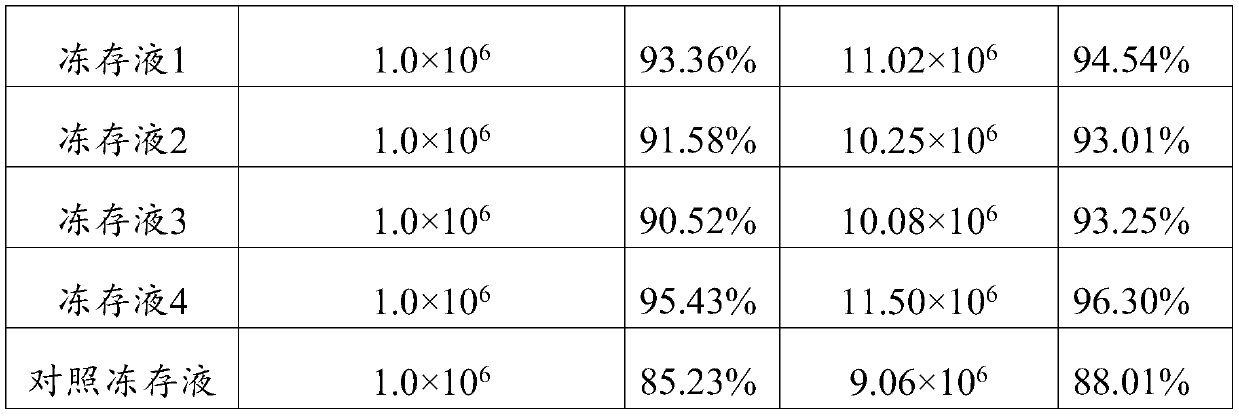Method for ultralow-temperature cryopreservation and resuscitation of mesenchymal stem cells
A technology of mesenchymal stem cells and stem cells, applied in the field of ultra-low temperature cryopreservation and recovery of mesenchymal stem cells, can solve the problems of reduced number of bone marrow mesenchymal stem cells, failure to collect, liquid nitrogen entry, etc., to reduce pollution and explode tubes during recovery risk, ensure the effect of freezing, and reduce the effect of liquid nitrogen entering
- Summary
- Abstract
- Description
- Claims
- Application Information
AI Technical Summary
Problems solved by technology
Method used
Image
Examples
Embodiment 1
[0030] Example 1: Acquisition of small pieces of umbilical cord tissue
[0031] 1) Take the treated umbilical cord of a healthy newborn born by cesarean section at full term, remove the ligated ends of the umbilical cord, and use ophthalmic scissors to cut the 10-15cm long middle section into a 2-3cm long umbilical cord tissue section, and use 1% double antibody (penicillin-streptomycin mixed solution) saline solution was repeatedly rinsed the umbilical cord tissue to remove blood stains.
[0032] 2) Dissect the above-mentioned umbilical cord tissue section, and remove the arterial and venous blood vessels (2 arteries and 1 vein) and epidermal tissue to obtain the umbilical cord Wharton's jelly tissue section, rinse repeatedly with saline containing 1% double antibody, Cut it into pieces of Wharton's jelly tissue about 3mm×3mm×1mm.
Embodiment 2
[0033] Example 2: Adhesive culture of Wharton's jelly tissue pieces and acquisition of primary mesenchymal stem cells
[0034] 1) According to 1 piece / cm 2 Shred to 4~10mm 3 Human umbilical cord Wharton's jelly tissue pieces of the same size were inoculated into cell culture dishes with a diameter of 10 cm and placed on the wall, and about 30-50 pieces of the tissue pieces were added to each culture dish, and the tissue pieces were air-dried for about 15 minutes to reduce the Moisture, strong adhesion to the wall;
[0035] 2) Gently add 7 mL of complete medium consisting of basal medium (α-MEM Cornig) and serum substitute (Helios GMP grade) to each Petri dish (which contains 3% volume ratio of serum substitute), do not Blow up the tissue block and then place it in 37°C, 5% CO 2 Incubation in an incubator; 5 mL of fresh complete medium was replaced after 5 days of culture, and the culture was continued for 5-9 days, during which time a new complete medium was replaced every ...
Embodiment 3
[0038] Example 3: Subculture of mesenchymal stem cells
[0039] 1) The mesenchymal stem cells (the primary human umbilical cord mesenchymal stem cells prepared in Example 2 were used for the first expansion and culture, that is, the P0 generation) were measured by a cell counter and the cell viability was calculated by trypan blue staining , the above-mentioned mesenchymal stem cells were inoculated into T175 cell culture flasks, and the initial seeding density was about 6×10 3 / cm 2 , the total volume is 25mL / bottle;
[0040] 2) Place the cell culture flask at 37°C, 5% CO 2 Cultivate in the incubator for 3-4 days. When the confluence of the cells reaches 80%-90%, discard the culture medium in the culture flask, wash it twice with normal saline, and then add 7 mL of TrypLE to each culture flask to fully digest the cells. About 3-5 minutes to digest;
[0041] 3) After the pseudopodia of the cells are completely retracted and the cells become round, add 7 mL of the complete me...
PUM
| Property | Measurement | Unit |
|---|---|---|
| diameter | aaaaa | aaaaa |
Abstract
Description
Claims
Application Information
 Login to View More
Login to View More - R&D
- Intellectual Property
- Life Sciences
- Materials
- Tech Scout
- Unparalleled Data Quality
- Higher Quality Content
- 60% Fewer Hallucinations
Browse by: Latest US Patents, China's latest patents, Technical Efficacy Thesaurus, Application Domain, Technology Topic, Popular Technical Reports.
© 2025 PatSnap. All rights reserved.Legal|Privacy policy|Modern Slavery Act Transparency Statement|Sitemap|About US| Contact US: help@patsnap.com


